Playtime for Everyone An Adapted Sensory Play Station
ABSTRACT
One of the principles of education, the Least Restrictive Environment Principle (LRE), states that a child with a disability is to be placed in the most natural educational environment possible (1). This project promotes the LRE Principle at Parkwood Elementary School by providing an adjustable height play station with sensory activities that will allow children with and without disabilities to interact, learn academic concepts, and develop motor skills. The device is separated into two parts: 1) an adjustable height play station table and 2) adapted sensory toys for use with the play station table. The completed device allows children of different abilities, heights and/or children using a wheelchair to interact with others at the same eye level.
KEYWORDS
Inclusion, sensory activity, adjustable height, play station
BACKGROUND
Recently, a strong emphasis has been placed on the early inclusion of children that have disabilities into an educational environment with children that do not have disabilities. Studies indicate that students with disabilities demonstrate an increased performance when placed in a regular class alongside their non-disabled peers (1). The young child with a disability learns adaptive, social skills while having realistic life experiences with their peers (2). In turn, typically developing students have the opportunity to develop an understanding of differences among individuals.
A child with cerebral palsy who uses a powered wheelchair inspired the specific need for this device. Although the child has a strong IQ and is placed in a regular 1 st grade classroom, he is unable to participate in playtime learning. The many of the activities during playtime learning are not wheelchair accessible and with limited motor skills, he cannot manipulate typical toys. Due to limitations of commercial devices, the school desired a device that would foster interaction between students with disabilities and other students of varying abilities and characteristics.
PROBLEM STATEMENT
 |
The goal of this project was to develop an adjustable height play station with adapted sensory activities that would allow children with disabilities to interact with children without disabilities. The play station needed to be safe, allow for the interaction of 2 4 children, be movable, provide sensory experiences, and address academic concepts.
RATIONALE
Supplying this adapted sensory play station to the school will provide an environment for children of all abilities to have an equal opportunity for learning, social growth, and active participation in the classroom. The children will be able to learn concepts such as cause and effect, sinking vs. floating, and heavy vs. light while being in an environment that promotes teamwork and interaction.
DESIGN AND DEVELOPMENT
 |
Throughout the project we met with an Occupational Therapist from the Durham Schools to ensure that the final device would meet the needs of the school. She provided us with useful insight into the problems with the play stations the school was currently using. We also met with several students to observe their different interests, heights, and abilities. This helped us to determine the level of adjustability and proper sensory activities that was needed in the device.
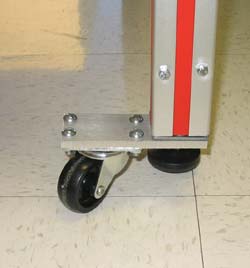 |
Our final design for the device (Figure 1) consists of two parts. The first part is the adjustable height play station table. The table frame is constructed from commercially available aluminum framing and connectors (3). This design makes the table sturdy, lightweight, and weather resistant. Per the therapist's request, the table was constructed to 25.5 wide by 37.5 long making it small enough to fit through a doorway and still allow multiple children to interact. This also allows two inexpensive, commercial plastic bins with lids to fit into the top of the play station frame. These bins are removable to allow the sensory medium such as sand or water to be changed. To provide height adjustability, the Movotec Lift System (4) was bolted to the legs of the frame. The lift system allows for the table height to be adjusted from 25 to 37 by turning the crank of a hydraulic pump (Figure 2). To prevent the crank from becoming accessible to children, a cable lock mounted on the frame. When the legs are extended to accommodate a child in a wheelchair, wooden platforms are provided to children for whom the table is too high. To improve mobility of the table, a feature requested by the educators, custom mounts made from aluminum were used to attach the wheels to the table legs (Figure 3). This design allows the wheels to move freely through their entire range of motion without interfering with the lift system's legs.
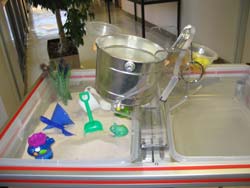 |
The second part of the device is the sensory activities. These activities promote interaction between children and provide exposure to academic concepts. Two custom designed toys are permanently mounted to the frame. The first, called the Tipsy Toy (Figure 4), consists of a bucket attached to a string. When the string is pulled, the bucket tips over, pouring its contents into one of the activity bins. The Tipsy Toy is designed to have one or more students responsible for filling the bucket, while another student is responsible for pulling the string. A large ring is provided on the end of the string so that a child with limited motor ability can operate the toy. This activity will improve motor skills and encourage teamwork while addressing the academic concepts of cause and effect and gravity.
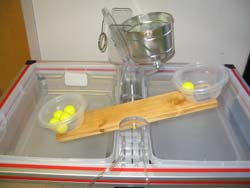 |
The second custom toy is a teeter-totter (Figure 5). The teeter-totter is constructed out of weatherproofed wood with plastic containers secured to each end using Velcro. Since the beam is mounted in the middle of the table, one student can fill one container while another student fills the other container. This activity addresses the academic concept of heavy vs. light and more vs. less.
The occupational therapist mentioned that teachers often use a bin filled with water to address the concept of floating vs. sinking. With this in mind, we mounted a commercial hand pump (Figure 6) to the teeter-totter base. When a student squeezes or presses down on the pump, water shoots out of the hose and into the activity bin. This provides the student with a fun activity to improve their motor skills. The pump is easily removed when water is not in the activity bin. In addition, several commercial sensory toys were purchased to add exciting, educational elements to the play station (Figure 7).
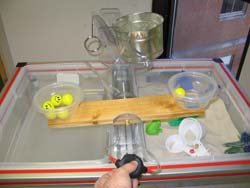 |
EVALUATION
During the design and development process, the play station was tested and evaluated by fellow classmates and professors. Input on the device was also gathered from the occupational therapist and additional grade school teachers. One initial concern was that the activities would depend on the ability of the student. To address this concern, the Tipsy Toy, Teeter Totter, and Pumps were designed and mounted in the middle of the table to encourage group interaction. A final concern was the possibility of the table tipping over. It was calculated that for the worse case scenario the minimum force required for the table to start lifting off the ground is 43 lbs. In testing the device it was determined that the play station was not likely to tip over unless under unlikely conditions.
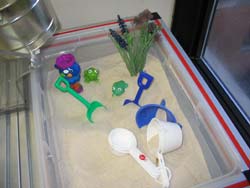 |
DISCUSSION AND CONCLUSIONS
Playtime for Everyone successfully meets several needs of the client. The device provides an adjustable height play station with adapted activities that promote social interaction and the LRE principle. The device requires that the students work together to use many of the various toys while addressing academic concepts. The main disadvantage to the device is the limited number of activities. Future work for the device would involve developing additional adapted activities that encourage interaction. As delivered, Playtime for Everyone unites children with a vast range of abilities, sizes, imaginations, and ideas in an environment where they can foster important life skills and learn from one another. This durable design will provide years of fun and learning for everyone; Playtime for Everyone leaves no child behind.
REFERENCES
- Summary Guidance on the Inclusion Requirement for Title I Final Assessments. 4 April 2000. Online posting. United States Department of Education. < http://www.ed.gov/policy/elsec/guid/inclusion.html>.
- Kolucki, Barabar. A Historic Perspective: Inclusion for Infants and Young Children with Disabilities. 2 April 2000. Online Posting. Disability World. < http://www.disabilityworld.org/April-May2000/Children/Historic.htm >.
- Bosch-Rexroth Inc. Online Catalog. <http://rexroth.starlinear.com/framing_cat/product.asp?menu=61>.
- Suspa Inc. Online Catalog. < www.suspa-inc.com >.
ACKNOWLEDGEMENT
This material is based upon work supported by the National Science Foundation under Grant No. 0118558. We would like to give special thanks to Suspa Inc. and Automation Technologies for the generous donation that they made to this project as well as to Dr. Bohs, Mark Palmeri, and Joe Owen for their guidance and support throughout the project.
AUTHOR CONTACT INFORMATION:
David J. Rodrian,
Duke University
200 Glengary Court Apartment 103
Durham, NC 27707
515-231-9256
EMAIL: dave.rodrian@duke.edu
Lauren J. Matic,
Duke University
10202 McQueen Dr
Durham, NC 27705
EMAIL: lauren.matic@duke.edu
